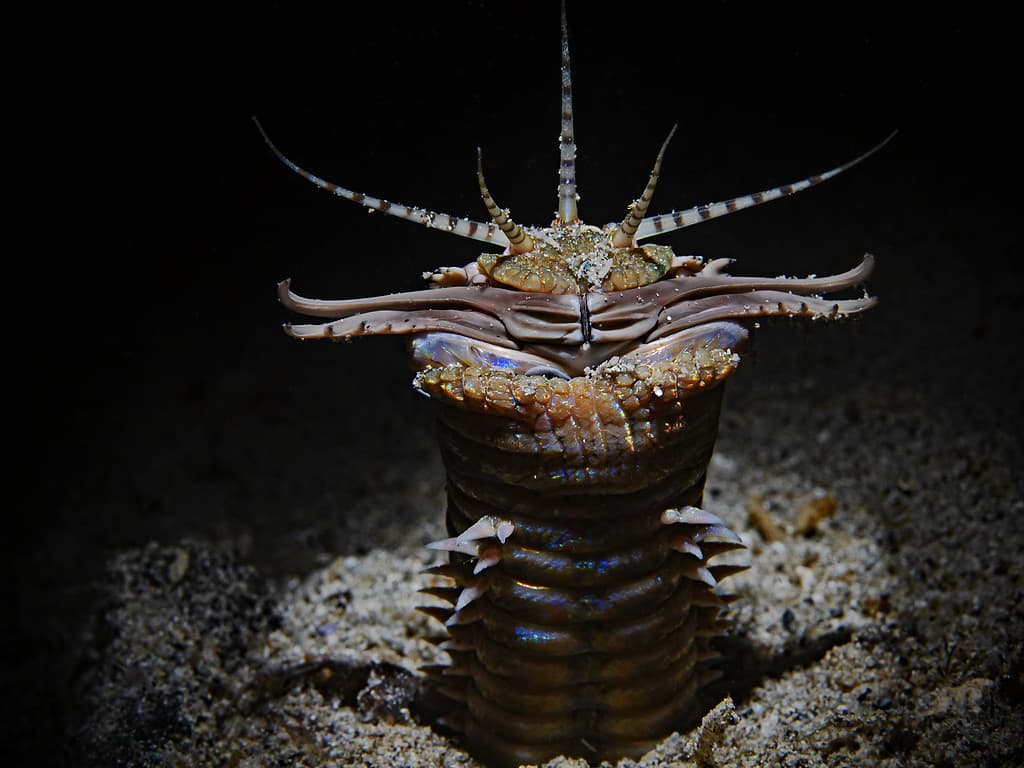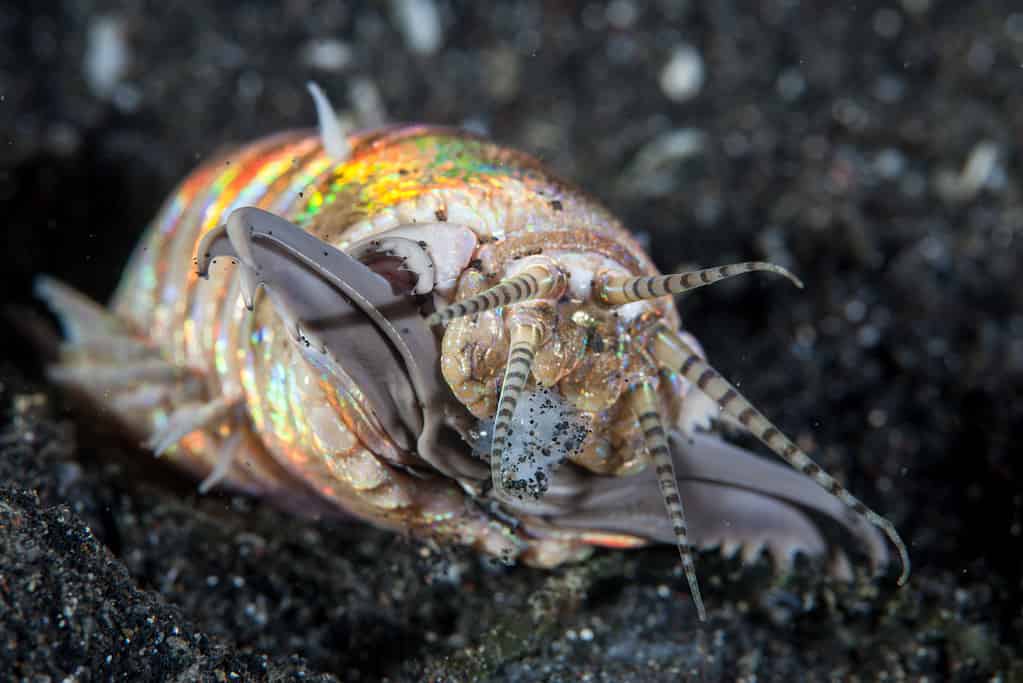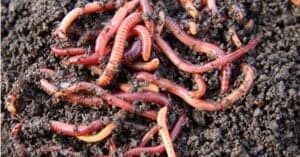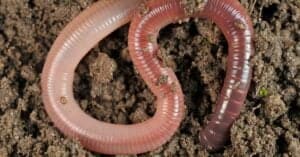If you’re like most people reading this, you’re probably wondering what a bobbit worm is and why you’ve never heard of it. Overall, it looks like something that was born in someone’s nightmare and escaped. This seaworm certainly stirs up not-so-fond memories of the worm in The Nightmare Before Christmas, Dune, and Tremors. Maybe these alien-like worms are really just looking for spice? At any rate, this interesting sea beast, sometimes also called a bristle worm, creates confusion among scientists and average folks alike. Let’s delve into what makes this terrifying fish-snatching creature tick, what it eats, and where it lives.
Bobbit Worm (Eunice aphroditois)

Nothing seems more disturbing than a Bobbit worm at night.
©scubaluna/iStock via Getty Images
| Description | Scientific Name | Latin Meaning |
| Phylum | Annelida – this covers 17,000 segmented or ringed worms such as earthworms and leeches. | Little ring |
| Class | Polychaeta – covers 10,000 marine bristle worms | With much hair or with long flowing hair |
| Order | Eunicida – covers 1,411 species of marine worms | Free Moving |
| Family | Eunicidae – rear segment with one through three antennae | Free, victorious |
| Genus | Eunice – covers marine ambush worms | Annelida – this covers 17,000 segmented or ringed worms such as earthworms, and leeches. |
The Bobbit worm is an interesting creature, but many people have not heard of it. It is capable of some serious violence, but remember; this is an animal doing what it needs to in order to survive and feed itself. Contrary to popular belief, the Bobbit worm did not arrive on this planet to promote nightmares. The worm didn’t choose how it hunts or must hide for its entire life. This is just an earthly creature who’s doing its best to survive and continue its species
Some creatures are absolutely terrifying to humans, but humans are and likely always will be the most violent, malicious creatures the world has ever seen. If you aren’t a fan of marine life, just stay on land, and you’ll be fine. This mysterious creature’s fossils date back at least 20 million years. They obviously have a purpose and important role to play in the marine ecosystem.
Appearance:
These strange worms can actually appear beautifully colored and can range from bright metallic purple to orange or pearl to even a rainbow-like metallic black. Scientists have recorded 10 different color morphs found just off the Scandinavian coast. They are all iridescent, but that doesn’t help the fact that they are savage and rather terrifying killers. These strange creatures do not have “seeing” eyes simply because they do not need any. They remain buried for their entire lives and use their antennae and bristles to act as their “eyes” when hunting for fish and crustaceans or when digging tunnels. They have five banded antennae, with two of them being pedipalps, as seen on arachnids. These palps are there to help navigate food into their mouths, along with aiding in the taste and touch of the food.
The Bobbit worm has two types of mandibles. The first are the actual jaws of the worm, while the others are the maxillae. The six maxillae are very sharp and serrated. These are responsible for enabling the worm to cut fish in half. The prostomium is the worm’s head in front of its mouth. On the prostomium are the worm’s two nearly blind eyes.
On the topic of staying buried, the Bobbit worm is extremely muscular. One would have to be to dig burrows as deep as 130 feet in the sea bed! Those muscles provide the momentum and ability to shoot out of the seabed to snag a tasty fish. If you’ve ever tried swimming fast in the ocean, you know that going fast in the water is hard work.
To make things even a little more bizarre, the muscular body of the worm is covered in thick bristles. The coarse bristles, called chitin, are constructed from a fibrous substance, hence the name bristle worm. The bristles are there to help the worm hold itself still under the seabed so unsuspecting fish do not see the worm and swim away. The bristles also work a double shift as anchors for when the worm pounces on prey. Without the bristles, the force of the lunge might make the worm come free of the seabed and float off, which would certainly ruin its meal.
Size:
The longest measured Bobbit worm was 9.81 feet long. Some people have spoken of these worms reaching 50 feet or more, yet none were ever recorded. Typically, the Bobbit worm ranges between two and four feet long, which is still scary but not nearly as nightmare-inducing as 10 feet! Though they are capable of growing to 10 feet, the Bobbit worm’s width is only an inch at most.
The Bobbit worm’s size is capable of changing without notice when it chooses to separate from itself when in danger. It can make a clone of itself and then have two or more different worms. This may also occur when the worm becomes damaged or cut in half. This part really adds to their scare factor!
Weight:
Up to 16 ounces or half a pound, which sounds incredibly light compared to their potential to reach 10 feet or more in length. Just to give you a very rough comparison, a 10 foot blue shark weighs approximately 400 pounds.
Lifespan:
Up to 3 – 5 years, though little is known about the species. It is unknown how long each cloned worm can live or if its life shortens each time. Much research may still needed to grasp a clear understanding of this bizarre species.
Diet:
The Bobbit worm has a taste for fish, crustaceans, and random plants. It clearly aims for a balanced diet, because it is important to stay fit when you need to be able to lunge out of your secret hiding place at 14 miles per hour to tear fish in half.
When hunting, the Bobbit worm will use its bristles to help dig the worm down into a tunnel. Once fully covered, they only leave a small portion of their bodies in very shallow sand or mud. The rest of that massive body will be deep within the tunnel and far from a fish’s viewpoint. The only part not hidden is their striped antennae, which look like innocent tiny worms to an unsuspecting fish.
Though argued a bit online, the Bobbit fish is venomous and shoots a necrotizing toxin into its prey before consuming. This is a bit confusing since they are able to bite a fish in half with a single bite, but they do go after much larger prey than themselves. Sometimes the worm needs to safely be able to drag the larger, weightier fish back into their den before consuming without facing a rebuttal attack from their prey. The bristles also hold a neurotoxic venom.
Though they tend to eat mostly fish, the worms will also snack on algae and work as a body removal system for the ocean by eating decaying matter. Scientists believe the Bobbit worm has evolved very little, if any, over its 20 million years on the planet. Other worms and fish likely hunted in the same fashion back then.
Habitat:
It lives in the warm waters of the Atlantic and Pacific near Indonesia. These strange worms enjoy spending their time buried along muddy or sandy seabeds and in coral, where their sneak attack works the best for catching prey.
The burrows can be 8 feet long and come lined with a mucous-like substance. This is similar to their burrowing cousins, the earthworms. The deepest burrow measured 130 feet beneath the ocean floor.
Reproduction:
The female Bobbit worm will emit a powerful pheromone into the ocean water, which signals the male worms to release semen. Once this happens, the females will release eggs that mix with the semen. This behavior is called swarming. Most of the eggs and baby Bobbit worms will be eaten or otherwise lost, so maybe they have a vendetta against the fish from the very beginning.
Behavior:
The Bobbit worms bury themselves in shallow mud or sand with their antennae sticking out. Their antennae will alert them when a fish or crustacean gets too close, and they will lunge out of their hiding spot and grab the fish. Sometimes they become carried away and actually cut the fish in half with one bite. They then retreat back into their lair to eat their kill.
As a nocturnal hunter, the Bobbit worm will reposition itself when needed and hunt on the ocean floor while some fish are sleeping, making this predator truly what fish nightmares are made of. Just be glad you aren’t a fish or crustacean!
How the Bobbit Worm Got Its Name

This rather beautiful, glittery, rainbow-emitting worm is named after none other than the Loraina and John Bobbit “situation” in 1993.
©Velvetfish/iStock via Getty Images
You may have guessed the answer to this question already. The answer is yes; the Bobbit worm is named for the action Lorena Bobbitt took on her husband in 1993. The Bobbit worm is said to look like Mr. Bobbit’s severed genitalia, while the teeth of the Bobbit worm represent the cutting action Mrs. Bobbit used to detach it.
It gets weirder. The name is somewhat derived from a myth. Some say the Bobbit worm female cuts off the genitalia of the male worm after mating and feeds it to her young. The Bobbit worms do not have genitalia comparable to humans, so this is definitely not true.
Fun Facts
- The longest creature on record is the Lineus longissimus, which is also a worm. This beast is a ribbon worm 180ft long!
- The Bobbit worms can have as many as 673 segments in their bodies!
- If you were to cut a Bobbit worm in half, it would regenerate and form two separate worms. Creepy.
- Bobbit worms do not have a brain. Instead, they have a nerve cell cluster located in their nervous system. See? They aren’t capable of being malicious.
- Sometimes the worm will grab a fish, and neighboring fish that are or aren’t the same species will gang up on the Bobbit worm by shooting jets of water at it. The worm apparently hates this and will retreat into its burrow. Other times, fish who wish to forage for food, where a suspected Bobbit worm may be, will shoot these jets of water down into the seabed until the worm shows itself by going after imaginary prey. Then the fish will shoot rapid-fire water jets at the worm until it goes off to hide, then the fish forage where they wish.
- Sometimes, the Bobbit worm will end up in an aquarium, likely from a piece of living coral. The result will not be good for the fish inside, and they are very difficult to remove. If handled, the worm can split into segments and regenerate, creating more worms. The tiny pieces can easily hide in rocks or coral and make it almost impossible to eradicate from any aquarium.
- The bristles all along the body of the Bobbit worm have a dangerous venom that, if touched or stepped on, can cause permanent nerve damage.
The photo featured at the top of this post is © scubaluna/iStock via Getty Images
Thank you for reading! Have some feedback for us? Contact the AZ Animals editorial team.






